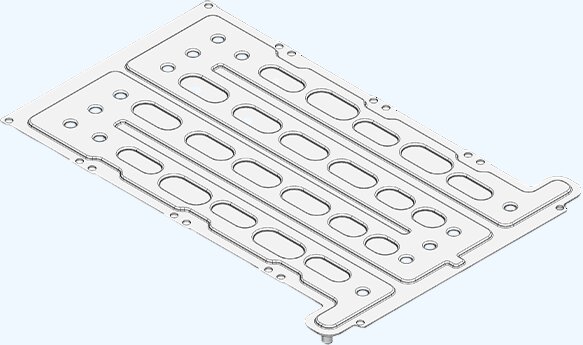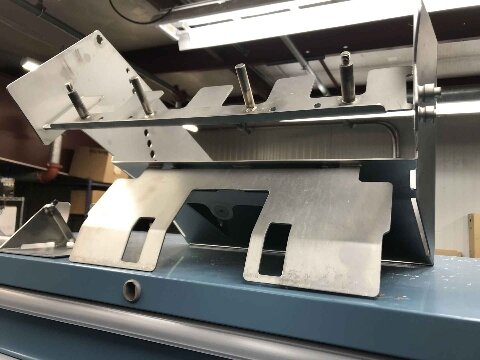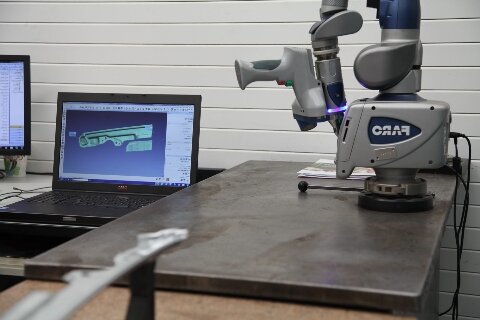금속 부품을 설계하거나 소싱할 때 엔지니어와 제조업체는 종종 비용과 리드 타임 측면에서 프로젝트에 가장 적합한 생산 방법은 무엇일까요? 잘못된 공정을 선택하면 시간 낭비, 비용 증가, 심지어 부품 고장으로 이어질 수 있습니다. 많은 사람들이 모든 금속 부품이 같은 방식으로 제작된다고 생각하지만, 실제로는 부품마다 다른 제조 공정에 가장 적합한 방식이 있습니다.
그렇기 때문에 판금 제작과 판금 스탬핑의 차이점을 이해하는 것이 중요합니다. 각 방법에는 고유한 장점과 한계, 이상적인 사용 사례가 있습니다. 생산 속도, 비용, 정밀도 및 재료 성능 측면에서 어떻게 다른지 이해함으로써 엔지니어는 비용을 절감하고 품질을 개선하며 리드 타임을 단축하는 보다 정보에 입각한 결정을 내릴 수 있습니다.
다음 섹션에서는 각 프로세스의 작동 방식과 최상의 성능을 발휘하는 위치에 대해 설명하여 디자인, 예산 및 생산 목표에 맞는 제조 방법을 결정하는 데 도움을 드립니다.
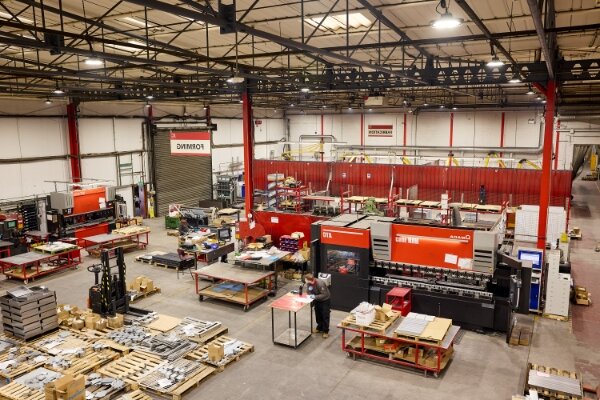
전통적인 판금 제작이란 무엇인가요?
전통적인 판금 제작 은 수작업과 기계 작업을 결합하여 금속 재료를 절단, 구부리기, 리벳, 압입, 카운터싱크, 엠보싱, 용접 및 조립하여 완성된 부품으로 만드는 종합적인 제조 공정입니다. 이 방법은 높은 유연성을 제공하여 엔지니어가 값비싼 금형 없이도 프로토타입과 소량 부품을 신속하게 제작할 수 있습니다. 또한 저렴한 비용으로 빠르게 설계를 변경할 수 있습니다.
핵심 프로세스
전통적인 판금 제조는 일반적으로 여러 성형 및 접합 작업을 결합하여 평평한 금속판을 기능성 부품으로 변환합니다. 각 단계는 치수 정확도, 구조적 강도 및 전반적인 품질을 보장합니다.
- 자르기: 레이저 절단, 전단, 워터젯 절단를 사용하거나 와이어 절단을 사용하여 내부 구멍을 포함한 디자인 치수와 일치하는 평평한 모양을 만듭니다.
- 굽힘: 사용 브레이크 누르기시트를 다이와 V 홈 사이에서 눌러 0°~180° 범위의 정밀하고 부드러운 각도를 형성합니다.
- 용접: MIG, TIG 또는 스폿 용접과 같은 기술은 부품을 영구적으로 결합하여 강력하고 매끄러운 어셈블리를 만듭니다.
- 고정 및 하드웨어 삽입: 리벳팅, 클린칭 또는 PEM 너트, 스터드 및 나사 설치와 같은 공정은 부품 강도를 높이고 조립을 간소화합니다.
- 마무리 옵션, 와 같은 파우더 코팅, 브러싱, 아노다이징, 패시베이션 또는 페인팅을 통해 외관을 개선하고 내식성을 향상하며 경우에 따라 전기 전도성을 높일 수 있습니다.
- 집회: 가공된 부품을 정렬, 장착 및 고정하여 배송 또는 바로 사용할 수 있는 완전한 어셈블리를 형성합니다.
기능
전통적인 판금 제작은 단일 프로토타입부터 전체 어셈블리에 이르기까지 다양한 프로젝트를 처리할 수 있습니다. 엄격한 공차, 우수한 표면 마감, 안정적인 구조적 무결성을 달성할 수 있습니다.
일반적인 제품으로는 인클로저, 브래킷, 패널, 캐비닛, 프레임, 커버 등이 있습니다. 또한 제작업체는 산업 및 전자 시스템에 사용되는 용접 구조물, 랙, 콘솔, EMI/RF 쉴드, 버스바 등을 제작합니다.
많은 워크샵에서 마감, 하드웨어 설치 및 기계 조립을 포함한 사내 서비스를 제공합니다. 이를 통해 리드 타임을 단축하고 배치 전반의 일관성을 개선할 수 있습니다. 복잡한 프로토타입이든 소규모 생산이든, 전통적인 판금 제작은 까다로운 요구 사항을 충족하는 데 필요한 유연성과 정밀성을 제공합니다.
일반적인 생산량 및 애플리케이션
전통적인 판금 제작은 중소규모 생산에 가장 적합합니다. 맞춤형 작업을 위한 설정 시간이 짧고 큰 공구 교체 없이 설계를 수정할 수 있습니다.
따라서 전자 제품, 의료 기기, 자동차 프로토타이핑, 기계 부품, 서버 시스템, 배터리 팩, 주방용품, 금속 가구 등 유연성과 빠른 처리 시간을 중시하는 산업에 이상적입니다.
제조업체는 종종 이 방법을 사용하여 맞춤형 인클로저, 제어 패널, 테스트 픽스처 및 정밀 하우징을 생산합니다. 각 프로젝트는 특정 요구 사항에 맞게 조정할 수 있으므로 전통적인 판금 제작은 맞춤형 고품질 부품을 찾는 엔지니어에게 탁월한 선택입니다.
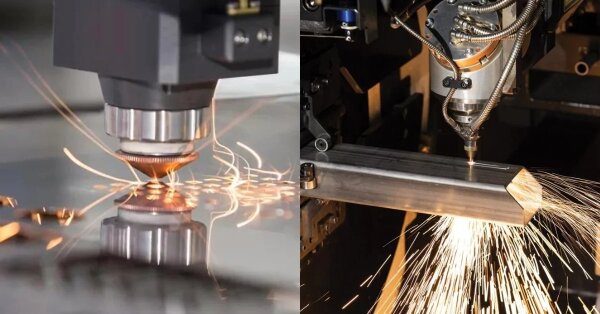
판금 스탬핑이란 무엇입니까?
판금 스탬핑 는 특수 금형과 고속 프레스를 사용하여 평평한 금속판을 특정 부품으로 성형하는 공정입니다. 여러 단계의 수작업이 필요한 기존 제작 방식과 달리 스탬핑은 한 번 또는 여러 번의 프레스 스트로크로 성형이 완료되므로 빠르고 정확합니다. 구조가 단순한 부품의 경우 스탬핑을 사용하면 한 번의 작업으로 전체 모양을 만들 수 있는 경우가 많습니다.
프로세스 개요
판금 스탬핑 공정은 일반적으로 평평한 시트나 코일을 스탬핑 프레스에 공급하는 것으로 시작됩니다. 프레스는 제어된 압력을 가하여 금속을 다이 캐비티로 밀어 넣어 원하는 모양을 형성합니다. 디자인에 따라 다양한 스탬핑 기술이 사용될 수 있습니다:
- 블랭킹: 성형 전에 판금에서 평평한 모양을 절단합니다.
- 꿰뚫는: 시트에 구멍이나 구멍을 뚫습니다.
- 굽힘: 한 번의 프레스 스트로크로 각도 또는 플랜지를 형성합니다.
- 딥 드로잉: 시트를 다이 캐비티로 당겨 속이 비어 있거나 곡선형 부품을 형성합니다.
- 코이닝: 고압을 가하여 정확한 치수, 매끄러운 표면 또는 필요한 곳에 허용되는 평탄도를 달성합니다.
- 엠보싱: 강도를 높이거나 시각적 매력을 향상시키기 위해 돌출 또는 오목한 패턴을 만듭니다.
이러한 작업은 개별적으로 수행하거나 연속 프레스 사이클에서 여러 단계를 수행하는 프로그레시브 다이에 통합하여 수행할 수 있습니다. 이 설정은 속도, 효율성 및 부품 일관성을 크게 향상시킵니다.
툴링 및 장비
판금 스탬핑은 일관된 고속 생산을 달성하기 위해 고정밀의 내구성이 뛰어난 툴링이 필요합니다. 각 금형은 특정 부품에 맞게 맞춤 제작되며 정확한 설계 요구 사항을 충족해야 합니다. 일반적인 장비에는 다음이 포함됩니다:
- 스탬핑 프레스: 성형력을 제공하는 기계식 또는 유압식 프레스. 부품 두께와 크기에 따라 다양한 프레스 톤수가 선택됩니다.
- 다이 및 펀치: 부품의 모양, 치수 및 특징을 정의하는 경화 강철 공구입니다.
- 피드 시스템: 시트 또는 코일 재료를 프레스에 일정한 속도로 공급하는 자동화된 메커니즘으로 효율성을 개선하고 수작업을 줄이며 작업자의 피로를 최소화합니다.
- 다이 유지보수 도구: 장기적인 정확성과 성능 일관성을 보장하기 위해 금형 세척, 연마 및 유지 보수에 사용되는 장비입니다.
일반적인 재료 및 두께 범위
판금 스탬핑은 냉연강, 스테인리스강, 알루미늄, 황동, 구리 및 티타늄을 포함한 다양한 재료를 지원합니다. 각 소재는 다양한 수준의 강도, 내식성 및 성형성을 제공하므로 엔지니어는 제품의 성능 요구 사항에 가장 적합한 소재를 선택할 수 있습니다.
일반적인 가공 두께는 재료 유형과 부품 디자인에 따라 0.2mm에서 6mm까지 다양합니다. 얇은 시트는 경량 부품에 이상적이며, 두꺼운 시트는 하중을 견디거나 강도가 높은 부품에 사용됩니다.
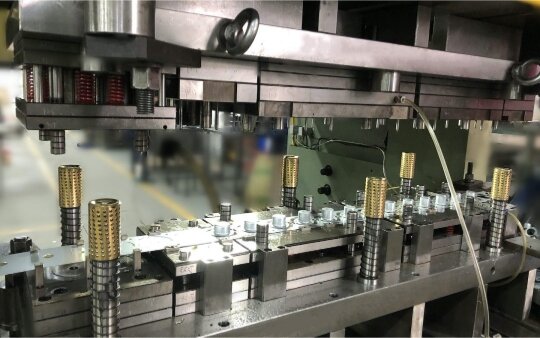
두 방법의 중요한 차이점
전통적인 판금 제조와 판금 스탬핑 모두 금속 부품을 생산하지만 생산 규모, 비용 구조, 정밀도 및 유연성 면에서 큰 차이가 있습니다. 일반적으로 제작은 다목적성과 맞춤화를 강조하는 반면, 스탬핑은 고효율과 대량 생산에 중점을 둡니다.
생산 효율성
전통적인 제작에는 절단, 굽힘, 하드웨어 삽입, 용접, 표면 처리, 실크 스크린, 레이저 조각, 조립 등 여러 단계가 포함됩니다. 각 단계마다 개별적인 설정과 취급이 필요하기 때문에 프로세스는 느리지만 유연성이 매우 높습니다. 중소규모 생산 또는 잦은 디자인 업데이트가 필요한 프로젝트에 이상적이며, 저렴한 비용으로 신속하게 변경할 수 있습니다.
이와는 대조적으로 스탬핑은 단일 사이클 내에서 여러 작업을 완료하는 자동화된 프레스에 의존합니다. 금형이 준비되면 최소한의 수동 입력으로 매우 빠른 속도로 부품을 생산할 수 있습니다. 따라서 스탬핑은 속도, 안정성 및 일관성이 중요한 대규모 생산에 선호되는 방식입니다.
비용 요소
가장 큰 비용 차이는 툴링 투자에 있습니다. 전통적인 제조 방식은 고가의 금형이 필요하지 않으므로 초기 설정 비용이 저렴하여 소량 배치 또는 프로토타입 제작에 이상적입니다. 주요 비용은 인건비와 기계 시간에서 발생합니다.
그러나 스탬핑에는 정밀하게 설계된 금형이 필요하므로 초기 비용이 많이 듭니다. 하지만 금형이 준비되면 개당 가격이 급격히 떨어집니다. 대량 생산 또는 연속 생산의 경우 대량 생산으로 인한 비용 절감 효과가 초기 툴링 투자를 빠르게 상쇄합니다.
부품 복잡성
전통적인 제작 방식은 복잡한 설계를 더 쉽게 처리하고 유연한 수정이 가능합니다. 엔지니어는 큰 혼란 없이 기능을 조정하고, 재료를 혼합하거나, 조립 방법을 변경할 수 있습니다. 따라서 프로토타입 개발, 맞춤형 인클로저 및 소량 생산에 이상적입니다.
반면에 스탬핑은 더 단순하고 반복 가능한 형상에 더 적합합니다. 금형을 제작하고 나면 디자인을 변경하려면 금형을 다시 제작해야 하므로 시간과 비용이 많이 듭니다. 그러나 스탬핑은 구멍, 굴곡, 엠보싱과 같은 여러 기능을 한 번의 작업으로 통합할 수 있어 대량 생산 시에도 높은 일관성을 유지할 수 있습니다.
정밀도 및 공차
전통적인 제작 방식은 일반적으로 장비의 정밀도와 작업자의 숙련도에 따라 ±0.05mm에서 ±0.20mm 사이의 공차를 달성합니다. 레이저 커터 및 CNC 프레스 브레이크와 같은 도구는 정확도를 향상시키지만 수동 용접 또는 조립 공정으로 인해 약간의 편차가 여전히 발생할 수 있습니다.
스탬핑은 고정된 툴링과 제어된 프레스 힘 덕분에 ±0.05mm 이내의 보다 높고 일관된 정확도를 제공합니다. 이러한 수준의 정밀도는 자동화된 어셈블리 또는 정밀 기계 시스템에 정확하게 맞아야 하는 부품에 매우 중요합니다.
부품 강도 및 구조적 무결성
전통적인 제조 방식에서는 용접, 리벳팅 또는 체결을 통해 부품을 결합합니다. 이러한 접합부에는 응력 집중 지점이 발생할 수 있지만 적절한 공정 제어와 고품질 용접을 통해 완성된 구조물은 여전히 견고하고 신뢰할 수 있습니다.
반면 스탬핑 부품은 용접 이음새나 접합선 없이 단일 금속판으로 제작됩니다. 연속적인 금속 입자는 전반적인 강도와 내구성을 향상시킵니다. 경우에 따라 성형 공정으로 인해 소재의 경도가 높아지는 경화 현상이 발생하기 때문에 스탬핑 부품은 고하중 또는 고응력 응용 분야에 특히 적합합니다.
프로젝트를 위한 전략적 선택
적절한 제조 방법을 선택하는 것은 프로젝트의 성공을 보장하는 가장 중요한 단계 중 하나입니다. 각 공정마다 고유한 강점이 있으며, 핵심은 제작 목표, 디자인 요구 사항 및 예산에 맞게 기술을 조정하는 것입니다.
생산량 평가
전통적인 판금 제작은 단가보다 유연성과 디자인 적응성이 더 중요한 1~1,000개 사이의 프로젝트에 가장 적합합니다. 설정 변경에는 일반적으로 1~3시간 밖에 걸리지 않으며 맞춤형 금형이 필요하지 않으므로 프로토타입, 파일럿 실행 및 특수 소량 부품에 이상적입니다.
반면 판금 스탬핑은 생산량이 10,000개를 초과하면 비용 효율성이 매우 높아집니다. 금형 제작이 완료되면 스탬핑 프레스는 최소한의 인력으로 연속적으로 가동할 수 있습니다. 하나의 고속 프레스 라인은 뛰어난 정밀도와 반복성으로 한 달에 500,000개 이상의 부품을 생산할 수 있습니다.
대규모 생산의 경우, 이러한 높은 처리량은 초기 툴링 투자를 빠르게 보상합니다.
부품 설계 복잡성 평가
전통적인 제작 방식은 엔지니어에게 부품 형상에 대한 더 큰 자유를 제공합니다. 여러 개의 벤드, 용접 또는 하위 구성 요소가 포함된 복잡한 어셈블리를 처리할 수 있으며 설계를 자주 변경할 수 있습니다. 예를 들어 벤딩과 용접 이음새가 10개 이상 있는 복잡한 인클로저나 프레임은 툴링을 변경하지 않고도 신속하게 수정할 수 있습니다.
스탬핑은 단순하고 반복 가능하며 디자인이 안정적인 부품에 가장 적합합니다. 금형을 변경하거나 재작업하는 데 몇 주가 걸리고 수천 달러의 비용이 들기 때문에 자주 업데이트해야 하는 프로젝트에는 비현실적일 수 있습니다. 그러나 프로그레시브 스탬핑은 디자인이 고정되어 있는 한 구멍, 리브 및 엠보싱이 있는 세부 부품을 처리할 수 있습니다.
리드 타임 및 예산 고려
리드 타임과 예산도 의사 결정의 핵심 요소입니다. 기존 제작 방식은 3~7일 이내에 프로토타입을 제작하고 2~4주 안에 소량 배치를 완료할 수 있습니다. 설정 시간이 짧기 때문에 디자인에서 생산으로 신속하게 전환할 수 있습니다.
그러나 판금 스탬핑은 금형 설계 및 제조로 인해 더 많은 준비 기간이 필요하며, 부품의 복잡성에 따라 보통 4~8주가 소요됩니다. 금형이 준비되면 생산이 매우 빠르게 진행되어 몇 시간 내에 본격적인 생산을 시작할 수 있으며 단가가 크게 떨어집니다.
비용 측면에서 보면
- 제작은 시작 비용은 낮지만 배치당 인건비와 기계 비용이 높습니다.
- 스탬핑은 초기 툴링 투자 비용이 높지만 장기 또는 반복 생산의 경우 단위당 비용이 훨씬 저렴합니다.
프로젝트를 시작할 준비가 되셨나요?
금속 부품 디자인에 생명을 불어넣을 준비가 되었다면 지금이 바로 실행에 옮기기에 가장 좋은 시기입니다. 고정밀 프로토타입, 맞춤형 소량 생산 또는 대규모 제조에 관계없이 적절한 공정을 선택하면 시간을 절약하고 비용을 절감하며 우수한 제품 품질을 보장할 수 있습니다.
가능한 한 빨리 부품 도면 또는 3D 모델을 보내주십시오.. 엔지니어링 팀이 설계를 검토하고 전문적인 권장 사항을 제공하며 의무 없이 신속하게 견적을 제공합니다.
안녕하세요, 저는 케빈 리입니다

지난 10년 동안 저는 다양한 형태의 판금 제작에 몰두해 왔으며 다양한 워크숍에서 얻은 경험에서 얻은 멋진 통찰력을 이곳에서 공유했습니다.
연락하세요

케빈 리
저는 레이저 절단, 굽힘, 용접 및 표면 처리 기술을 전문으로 하는 판금 제조 분야에서 10년 이상의 전문 경험을 갖고 있습니다. Shengen의 기술 이사로서 저는 복잡한 제조 문제를 해결하고 각 프로젝트에서 혁신과 품질을 주도하는 데 최선을 다하고 있습니다.

